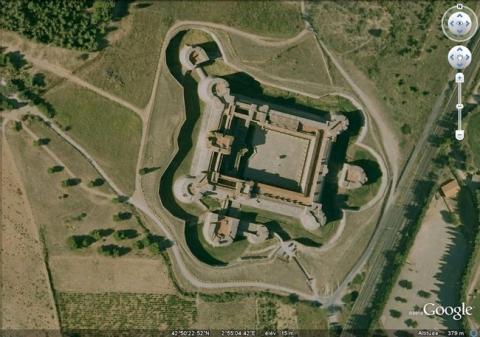Salses
History and description
The current château de Salses was constructed from 1497 by the Aragon engineer Francisco Ramiro Lopez, for king Ferdinand of Aragon. It replaced a medieval castle taken by the French in 1496 and restored to Spain the following year. Ferdinand of Aragon thus decided to replace this ancient construction, which was not suitable for metal artillery, to ensure improved defence of the passage between Languedoc and Roussillon. To enhance the defence, Lopez created an original fortress combining medieval and modern fortification. The castle was a rectangular work in a medieval shape with four medieval towers, three detached towers in a horseshoe shape and very thick stone walls (11 metres). It was sunk into the ground into very wide dry moats (15 metres), preceded by a glacis including two ravelins and equipped with countermines over its entire perimeter. In addition, the towers included casemates, which meant a projection considered difficult due to the circular shape of the towers. All were equipped with cannon emplacements. Inside, there were three areas: the main centre, the inner fortified structure separated from its predecessor by a flanking ditch and the keep. Two gates, to the west and south, allowed entry. The barracks and stables were situated along the walls of the main centre. The construction was completed in 1503, at the time of the first French siege which Lopez, commander of the garrison, managed to repel.Besieged multiple times, the château de Salses was taken by the French in 1642 during the Thirty Years war, and linked to France by the treaty of the Pyrenees of 1659. Subsequently, it progressively lost its status as a stronghold following the expansion of the frontier. Transformed into a prison in 1682, Vauban visited it in 1685 and smoothed over the parapets in 1691, although deeming it useless and advocated that it should be demolished completely.
Following the period of Vauban, the site deteriorated. The west gate was walled up in the 18th century. Under the French Restoration, in 1817, the keep was used as a powder keg.
Current state
The château de Salses has been classed as a historical monument since 1886 and is publicly accessible.
Salses
Salses
42° 50' 23" N, 2° 55' 6" E
Type
castle
Engineers
Francisco Ramiro Lopez, Sébastien le Prestre de Vauban
Department
Pyrénées-Orientales
Region
Occitanie
Bibliography
- AYATS (A.), Les fortifications de Vauban. Découverte guidée en pays catalan, Canet, 2007.
- FAUCHERRE (N.), La route des fortifications en Méditerranée, Paris, 2007.
- TRUTTMAN (P.), La forteresse de Salses, Rennes, 1985.
![Château de Salses, plan de 1693, dans Recueil des plans des environs de plusieurs places du Royaume faits en l’an 1693, [Paris], pl. 38, gallica.bnf.fr / Bibliothèque nationale de France. Château de Salses, plan de 1693, dans Recueil des plans des environs de plusieurs places du Royaume faits en l’an 1693, [Paris], pl. 38, gallica.bnf.fr / Bibliothèque nationale de France.](/sites/default/files/styles/paragraphe_libre/public/images/plan_ancien-56.jpg?itok=lLS0CNU_)
